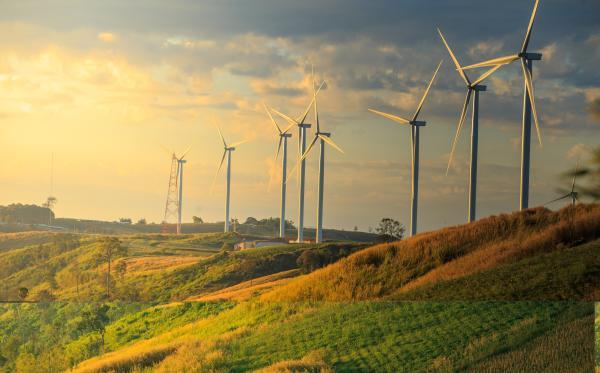
- MDBs publish 2020 Joint Report on Multilateral Development Banks’ Climate Finance
- Eight MDBs committed US$ 66 billion for climate finance in 2020, up from US$ 61.6 billion
- Of the total, 58 per cent was committed to low- and middle-income countries
Climate finance committed by major multilateral development banks (MDBs) rose to a total of US$ 66 billion last year from US$ 61.6 billion in 2019, according to the 2020 Joint Report on Multilateral Development Banks’ Climate Finance, published today. Of this, 58 per cent – or US$ 38 billion – was committed to low- and middle-income economies.
The total climate co-finance committed during 2020 alongside MDB resources was US$ 85 billion. Together, MDB climate finance and climate co-finance totalled more than US$ 151 billion. The amount of private direct mobilisation stood at US$ 5.9 billion.
Accelerating the transition to low-carbon and climate-resilient economies through climate finance is a key element of the MDBs’ effort to align their activities with the objectives of the 2015 Paris Agreement to keep global warming well below 2°C, with efforts to limit it to 1.5°C, along climate-resilient development pathways. In the past six years, the MDBs have jointly committed a total of US$ 257 billion in climate finance, of which US$ 186 billion was directed at low- and middle-income economies.
EIB Vice-President Ambroise Fayolle, commented: “To solve the climate crisis, we must mobilise trillions of dollars. Today’s report shows that despite the COVID-19 pandemic, MDBs provided crucial support to countries worldwide to build back better for a greener future. Importantly, MDB climate finance helped leverage important funding from other sources, including from the private sector. At the EIB, we are delighted to report record climate finance for 2020. Despite still much work to do in this area, we saw an important and encouraging step up in our support for climate change adaptation, which in 2020 doubled compared to previous years.”
The annual report is a key indicator on the progress MDBs are making on accelerating the delivery of climate finance, for which demand is clearly going to grow over time. This year’s report marks the end of the reporting period tracking individual climate finance pledges since 2015; for most, 2021 will mark the start of a new increase in ambition. In 2019, at the UN Secretary-General’s Climate Action Summit, MDBs announced their expected joint annual climate action finance to 2025. These include at least US$ 65 billion, with US$ 50 billion of MDB climate finance for low-income and middle-income countries; an increase in adaptation finance to US$ 18 billion; and private direct mobilisation of US$ 40 billion.
“The MDBs will continue to improve their tracking and reporting of climate finance in the context of their commitments to ensure consistent financial flows to the countries’ long-term, low-carbon and climate-resilient development pathways, as established in … the Paris Agreement,” says the 2020 report, which is the 10th in the series.
Of the 2020 total of US$ 66 billion, US$ 63 billion came from the MDBs’ own accounts and almost US$ 3 billion from external resources channelled through and managed by MDBs. These included the Climate Investment Funds (CIF), Green Climate Fund (GCF) and climate-related funds under the Global Environment Facility (GEF), EU blending facilities and others.
The 2020 financing helped play a key role in supporting countries to embed green and climate-focused solutions as part of their recoveries from the impact of COVID-19. While these programmes affected MDBs’ normal lending operations and thus the delivery of their climate finance targets, seeing the total commitments for low- and middle-income countries dip from 2019’s US$ 41.5 billion, the 2020 report says interventions and support from the MDBs laid a solid foundation for “building back better” for a greener, more resilient, post-Covid-19 future.
Nearly US$ 50 billion (76 per cent) of total MDB climate finance in 2020 was associated with climate change mitigation investments that aim to reduce harmful greenhouse gas emissions and slow down global warming. Of this, 50 per cent went to low- and middle-income economies. More than US$ 16 billion (24 per cent) for climate change adaptation finance was invested in adaptation efforts to help countries build resilience to the mounting impacts of climate change, including worsening droughts and more extreme weather events, from flooding to rising sea levels. Of this, 83 per cent was directed for low- and middle-income economies.
The 2020 MDB report, coordinated by the EBRD, combines data from the African Development Bank (AfDB), the Asian Development Bank (ADB), the Asian Infrastructure Investment Bank (AIIB), the European Bank for Reconstruction and Development (EBRD), the European Investment Bank (EIB), the Inter-American Development Bank Group (IDBG), the Islamic Development Bank (IsDB) and the World Bank Group (WBG). AIIB data is fully incorporated for the first time. As part of the MDBs’ ambition to extend and enhance climate finance reporting, the 2020 report also summarises information on climate finance tracking from the New Development Bank (NDB), presented separately from the joint figures and not yet included in the MDB climate finance total.
The European Investment Bank is active in around 160 countries and is the world’s largest multilateral lender for climate action projects. The EIB Group has recently adopted its Climate Bank Roadmap to deliver on its ambitious agenda to support EUR 1 trillion of climate action and environmental sustainability investments in the decade to 2030 and to deliver more than 50% of EIB finance for climate action and environmental sustainability by 2025. Also, as part of the Roadmap, from the start of 2021, all new EIB Group operations will be aligned with the goals and principles of the Paris Agreement.